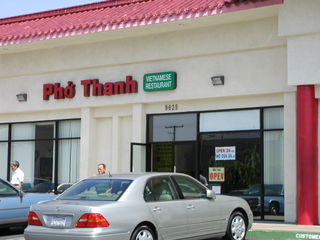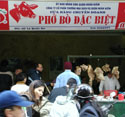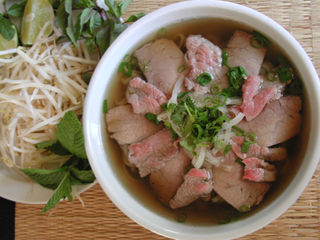Below is an article that I originally wrote for the San Jose Mercury News. It was published in 2004. The photos were taken by me, not the paper.
Ask someone to name a Vietnamese dish, and he or she will most likely say pho (rhymes with "duh''). Twenty-nine years ago, who would have dreamed that the national soup of Vietnam would be so well embraced in America?
Perhaps it's because Vietnamese emigrants decided to settle all over the United States, and wherever we are, there's sure to be pho. The heady broth, chewy rice noodles, sweet spices and scintillating herbs provide comfort in a bowl.

Long confined to Vietnam and immigrant communities, pho is becoming the most popular Asian noodle soup in the United States. Check the phone book for pho in Santa Clara and San Jose and you'll find more than 25 listings, including mom-and-pop operations and the prolific Pho Hoa franchises. One Southern California chain, Pho 2000, caters specifically to beef-loving Korean-Americans.
Pho has changed much during its nearly 100-year history. At its birth, pho was basically just boiled beef, noodles and broth. Inventive cooks then developed the raw beef version (pho bo tai) and chicken pho (pho ga), and during wartime when beef was scarce, they made pork pho (pho lon). Though these and other variations exist, most people define pho as a beefy affair.
American bowls of pho are about 30 percent bigger than what's found at a street-side joint in Vietnam. Also, American pho restaurants regularly offer diners myriad options to personalize their bowls: raw beef, cooked beef (such as brisket, flap or outside flank), tendon, tripe and meatballs.
This fanciful display is a reflection of America's wealth. That is, we have options here -- an uncommon luxury in Vietnam; in fact, if you're low on money in Vietnam you may order a less-expensive bowl without meat.
On a 2003 trip to Vietnam, I didn't get many choices. At a stall in Ho Chi Minh City's famous Cho Ben Thanh market, I ordered a bowl with chewy beef tendon and was told there was none that day -- just cooked and raw beef. All one extremely busy spot in Hanoi offered was pho with cooked beef. True to the purist northern tradition, the pho was steamy hot, and no leafy garnish plate appeared. But it was one of the best I'd ever eaten. Like the locals, I sat crouched on a tiny stool and slurped up every bit. When the bowl was empty, I happily paid 11,000 dong (about 60 cents) and departed with a beefiness that lingered on my lips all afternoon.
What makes pho universally loved?
Sacramento restaurateur, chef and cookbook author Mai Pham points out that Vietnamese food offers an appealing flavor profile to the U.S. palate: "Most of the ingredients are very familiar. It's fresh and not so spicy. Visually it's easy to see. It's not mysterious.''
A smart businesswoman with foresight, Pham partnered with StockPot, a Campbell Soup Co. subsidiary in Seattle, to develop a commercial pho broth. Though made of chicken, the broth contains the bold spice notes and sweet-salty flavors found in typical beef pho.
At San Jose State University, Executive Chef Jay Marshall uses the StockPot product at an Asian noodle soup bar where diners get to pick and choose from an array of rice noodles, vegetables, herbs and protein. Because there are plenty of pho shops near campus, the chef decided to use the product to offer a more non-traditional bowl of pho. "Our students love it,'' Marshall says. "People across the board eat it. It's not tied to any nationality.''
How pho came to be is a murky issue. While scholars, cooks and diners agree that pho was invented in the early part of the 20th century in northern Vietnam, no one is certain of the specifics.
Pham recalls that in the late 1990s, when she first returned to Vietnam to do research, she found that there wasn't much written or documented on pho. In gathering oral histories from elders, she concluded that the noodle soup came from Hanoi and was influenced by both Chinese and French traditions.

Last year pho's mysterious beginnings were debated and investigated at several events in Hanoi. At one seminar, the discussion focused on the word itself. Some proposed that "pho'' was a Vietnamese corruption of the French feu (fire), as in the classic boiled dinner pot-au-feu, which the French colonialists introduced to Vietnam.
In a follow-up publication, seminar organizer Didier Corlou, executive chef of the Sofitel Métropole hotel in Hanoi, noted that charring the onion and ginger for pho broth is similar to the French method of adding roasted onion to pot-au-feu for extra brown coloring. This use of charred ingredients is one thing that sets pho apart from other Asian noodle soups.
As for the birthplace of pho, a couple of theories point to Nam Dinh province, southeast of Hanoi. One argument is that ingenious cooks in Nam Dinh City (once a major textile center) satisfied the gastronomic desires of Vietnamese and French residents by inventing the dish using local ingredients (e.g., rice noodles) and adding du boeuf for a bit of foreign extravagance. (Before the French occupation, cows in Vietnam were cherished work animals, not food sources.)
Another theory attempted to trace pho to the small impoverished village of Van Cu in Nam Dinh province. During the 20th century, as a means of survival, nearly all Van Cu villagers turned to making and peddling pho 50 miles away in Hanoi. Consequently, many pho vendors in the capital today are from that village.
In 1954, under the Geneva Accords, Vietnam was split in two. To avoid communism, many northerners migrated southward, bringing their pho culture with them. In democratic South Vietnam, pho made a brash turn away from its conservative northern traditions.
It was embellished with more of everything -- meat, noodles and broth. The practice of garnishing pho with bean sprouts, ngo gai (thorny cilantro), hung que (Thai/Asian basil) and lime was introduced. Diners also started adding tuong (bean sauce/hoisin sauce) directly to their bowls. This freewheeling, adulterated incarnation reflected the southern Vietnamese penchant for eating wildly complicated food and lots of it.
Then, as now, northern pho purists reacted with horror, decrying the loss of authenticity. Though philosophically liberating, tinkering with the sacred broth was an affront to strict northern cooks, whose pride and reputation rested in crafting a well-balanced bowl.
Even today, what many Americans identify as the requisite pho garnish plate is hard to find in Hanoi. For purists like my northern-born mom, only "pho bac'' (northern pho) will do.
Whether you enjoy your next bowl of pho at home, in a restaurant or at a noodle bar, you'll be part of a special culinary and cultural transformation. Like many ethnic foods introduced to this country, part of pho will forever remain rooted in Vietnam while its future unfolds at the American table.
Related information:


















Tammy says
Hello Andrea,
I have enjoyed your site for some time, and your (first) cookbook sits on my kitchen shelf.
This is such a great piece, with so much information, I find it hard to believe I'm the first to comment on it. I've always loved pho, as any self-respecting person of (partially) Vietnamese ancestry does. I've just never known the entire background story. Sometimes, when you travel farther for something, you make more of an effort to get the full story. As I live in France, having my bo
Kade Riefenberg says
Pho is DAAAAAAAAAAAAANK
christian louboutin says
I'd like to read more from you,expecting your new articles.
monster energy hats says
Thank landlord impartiality. Come up with such a good article to share with us. This is the official information from articles I and my friends need. Thanks again!
cheap baseball hats says
I agree with your point of view of this article. This is a good article. Very timely given us so much useful information. Thank you!
Personal loans says
Yummyyy!!! looks like Pho Noodle Soup has an unforgettable taste.People of Vietnam are used to make this soup to entertain the foreign people.The writer has made an excellent pen through description of this soup.Thanks for sharing it.
red bottom shoes says
you are the best! I’m the greatest! you are invincible
Beats by Dr Dre says
I love people. I love my family, my children . . . but inside myself is a place where I live all alone and that's where you renew your springs that never dry up
marlon says
The writer has made an excellent pen through description of this soup.Thanks for sharing it.
Bin Loo says
Since when Pho was influenced by French dish??? What an ignorant author! You shamed to be called Vietnamese. The Vietnam's Television (VTV) once talked about the history of Pho, and it has nothing to do with French cuisine.
L. Nguyen says
I found this article helpful. And...
"the simple truth is, Viet folks have have never had the luxury of retiring elderly water buffalo "out to pasture." They go in the pot and every inch of them is used. When my grandfather returned to his natal village in rural North Viet Nam (in Nam Dinh province, said to be the birthplace of pho) in the 1990s for the first time since becoming a refugee in 1954, they honored him in age-old tradition: by slaughtering a water buffalo on his behalf, collecting
Cha lua co sa says
Pho is very difficult to cook. If you come to Vietnam, please visit Pho Le at 413 Nguyen Trai, Ho Chi Minh. This is one of the oldest pho restaurants in Vietnam. I enjoy pho here, it's better than any pho restaurant I've ever eaten.
Andrea Nguyen says
Pho Le is very good. I went there as part of my pho research and there's a photo of Pho Le in "The Pho Cookbook" on page 11! So happy you like it too. It's not hard to make pho if you practice. In America, there are larger kitchens with big stoves and you can have a large pot simmering for hours. Or, if you have a pressure cooker, pho can be made in 1 1/2 hours. Thank you for taking time to write from Vietnam.